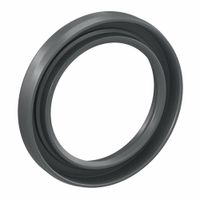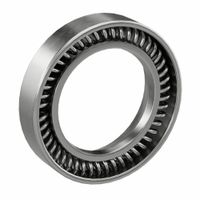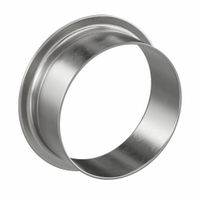Call +(254) 703 030 000 / 751 483 999 / 721 704 777
- Home
- Power Transmission
- Rotary Shaft Sealing
.....Read More
Frequently Asked Questions
What is the purpose of a rotary shaft seal?
The purpose of a rotary shaft seal, also known as a radial shaft seal or oil seal, is to maintain the integrity of a system by preventing the leakage of fluids along a rotating shaft. It serves several critical functions:
1. **Fluid Containment**: The primary role of a rotary shaft seal is to retain lubricants within the system, such as oil or grease, ensuring that the moving parts are adequately lubricated. This helps in reducing friction and wear, thereby extending the lifespan of the machinery.
2. **Exclusion of Contaminants**: Rotary shaft seals prevent external contaminants like dust, dirt, and moisture from entering the system. This is crucial for maintaining the cleanliness and efficiency of the machinery, as contaminants can cause abrasion, corrosion, and other forms of damage.
3. **Pressure Maintenance**: In certain applications, rotary shaft seals help maintain the necessary pressure within the system. This is particularly important in hydraulic and pneumatic systems where pressure differentials are critical for operation.
4. **Protection of Bearings**: By keeping lubricants in and contaminants out, rotary shaft seals protect bearings and other internal components from premature failure. This ensures smooth operation and reduces maintenance costs.
5. **Temperature and Chemical Resistance**: Rotary shaft seals are designed to withstand various temperatures and chemical exposures, depending on the material used. This makes them suitable for a wide range of industrial applications.
Overall, rotary shaft seals are essential components in mechanical systems, ensuring operational efficiency, reliability, and longevity by providing a barrier between the internal and external environments of rotating machinery.
How do rotary shaft seals work?
Rotary shaft seals, also known as lip seals or oil seals, are designed to prevent the leakage of fluids along a rotating shaft. They work by creating a barrier between the rotating shaft and the stationary housing, effectively sealing the internal environment from external contaminants and vice versa.
The primary components of a rotary shaft seal include the sealing lip, a metal case, and a garter spring. The sealing lip, typically made from elastomeric materials like nitrile rubber or silicone, is the part that makes direct contact with the shaft. It is designed to maintain a tight fit against the shaft surface, even as it rotates, to prevent fluid leakage. The metal case provides structural support and helps maintain the shape and position of the seal within the housing.
The garter spring, which is often embedded within the sealing lip, applies a consistent radial force, ensuring that the lip maintains contact with the shaft. This force compensates for any wear or thermal expansion that might occur during operation, maintaining the seal's effectiveness over time.
The seal operates by maintaining a thin film of lubricant between the lip and the shaft. This film reduces friction and wear, while also providing a secondary sealing action. The design of the lip, often featuring a hydrodynamic pattern, helps pump the lubricant back into the system, enhancing the seal's efficiency.
Rotary shaft seals are crucial in various applications, from automotive engines to industrial machinery, where they protect against fluid leakage, contamination, and ensure the longevity and reliability of the equipment.
What materials are rotary shaft seals made from?
Rotary shaft seals are typically made from a combination of materials to ensure durability, flexibility, and resistance to various environmental factors. The primary materials used include:
1. **Elastomers**: These are the most common materials for the sealing lip due to their flexibility and ability to maintain a tight seal. Common elastomers include:
- **Nitrile Rubber (NBR)**: Offers good resistance to oils and fuels, making it suitable for general-purpose applications.
- **Fluoroelastomer (FKM/Viton)**: Provides excellent heat and chemical resistance, ideal for high-temperature and aggressive chemical environments.
- **Silicone Rubber**: Known for its excellent temperature range and flexibility, often used in extreme temperature applications.
- **Ethylene Propylene Diene Monomer (EPDM)**: Offers good resistance to weathering, ozone, and water, suitable for outdoor applications.
2. **Polytetrafluoroethylene (PTFE)**: Known for its low friction and high chemical resistance, PTFE is used in applications requiring minimal wear and high-speed performance.
3. **Polyurethane**: Offers high abrasion resistance and is used in applications where durability is critical.
4. **Metals**: The casing or reinforcement of the seal is often made from metals such as:
- **Carbon Steel**: Commonly used for its strength and cost-effectiveness.
- **Stainless Steel**: Provides corrosion resistance, suitable for harsh environments.
5. **Fabrics and Composites**: Sometimes used in combination with elastomers to enhance strength and wear resistance.
These materials are selected based on the specific requirements of the application, including temperature range, chemical exposure, pressure, and speed. The combination of these materials ensures that rotary shaft seals can effectively prevent leakage and contamination in a wide range of industrial applications.
What is the difference between oil seals and grease seals?
Oil seals and grease seals are both used to prevent leakage and contamination in machinery, but they differ in their applications and design.
Oil seals, also known as rotary shaft seals, are designed to retain lubricants and exclude contaminants in systems where oil is the primary lubricant. They are typically used in high-speed applications such as engines, gearboxes, and pumps. Oil seals consist of a flexible lip that maintains contact with a rotating shaft, a metal case for structural support, and a garter spring to ensure consistent pressure on the shaft. The primary function of oil seals is to prevent oil leakage and protect against dirt, dust, and moisture ingress.
Grease seals, on the other hand, are used in applications where grease is the lubricant. They are commonly found in wheel bearings, axles, and other low-speed applications. Grease seals are designed to retain thicker lubricants and are generally simpler in construction compared to oil seals. They often have a lip made of rubber or other elastomeric materials that provides a tight seal against the shaft. Grease seals are effective in preventing grease leakage and keeping out contaminants like dirt and water.
In summary, the main differences between oil seals and grease seals lie in their application, design, and the type of lubricant they are intended to retain. Oil seals are used for high-speed applications with oil as the lubricant, while grease seals are used for low-speed applications with grease. The construction of oil seals is typically more complex due to the need to handle higher speeds and pressures.
How do you install a rotary shaft seal?
1. **Preparation**: Clean the shaft and housing to remove any debris or old sealant. Inspect for damage or wear.
2. **Select the Right Seal**: Ensure the seal matches the specifications for size, material, and type suitable for the application.
3. **Lubricate the Seal**: Apply a thin layer of lubricant to the seal lip and shaft to reduce friction during installation.
4. **Position the Seal**: Align the seal with the housing bore. Ensure the sealing lip faces the correct direction, typically towards the fluid to be retained.
5. **Use Installation Tools**: Employ a seal driver or a flat tool to press the seal evenly into the bore. Avoid using excessive force or hammering directly on the seal.
6. **Press the Seal**: Apply even pressure around the seal's circumference to seat it properly. Ensure it is flush with or slightly recessed in the housing.
7. **Check Alignment**: Verify the seal is aligned correctly and not tilted. Misalignment can cause leaks or premature wear.
8. **Inspect the Installation**: Ensure the seal is undamaged and seated correctly. Check for any signs of distortion or misplacement.
9. **Reassemble Components**: Once the seal is installed, reassemble any components that were removed during the process.
10. **Test the Seal**: Run the system to check for leaks or abnormal noises, indicating improper installation.
11. **Regular Maintenance**: Periodically inspect the seal for wear and replace it as necessary to ensure optimal performance.
What are common causes of rotary shaft seal failure?
Common causes of rotary shaft seal failure include:
1. **Improper Installation**: Incorrect installation can lead to misalignment, uneven pressure distribution, or damage to the seal, causing premature failure.
2. **Shaft Misalignment**: Misalignment between the shaft and the housing can cause uneven wear and increased friction, leading to seal degradation.
3. **Excessive Shaft Runout**: Excessive radial or axial movement of the shaft can cause the seal to wear unevenly or lose contact with the shaft.
4. **Contamination**: Dirt, dust, or other contaminants can enter the sealing area, causing abrasion and wear on the seal material.
5. **Inadequate Lubrication**: Insufficient lubrication can increase friction and heat, leading to accelerated wear and potential seal failure.
6. **High Operating Temperatures**: Excessive heat can cause the seal material to degrade, lose elasticity, or harden, compromising its sealing ability.
7. **Chemical Attack**: Exposure to aggressive chemicals or incompatible fluids can degrade the seal material, leading to swelling, cracking, or dissolution.
8. **Pressure Variations**: Fluctuations in pressure can cause the seal to deform or extrude, especially if the seal is not designed to handle such variations.
9. **Wear and Tear**: Normal wear over time can lead to a loss of sealing effectiveness, especially in high-speed or high-load applications.
10. **Improper Seal Material**: Using a seal material that is not suitable for the specific application conditions (temperature, pressure, chemical exposure) can lead to premature failure.
11. **Vibration**: Excessive vibration can cause the seal to lose contact with the shaft or housing, leading to leakage.
12. **Aging**: Over time, seal materials can lose their elasticity and resilience, leading to hardening and cracking.
Addressing these issues through proper design, material selection, installation, and maintenance can help prevent rotary shaft seal failure.
How do you choose the right rotary shaft seal for an application?
To choose the right rotary shaft seal, consider the following factors:
1. **Shaft Size and Speed**: Determine the shaft diameter and rotational speed. Seals are designed for specific size ranges and speeds, affecting their performance and lifespan.
2. **Operating Environment**: Assess the environmental conditions, including temperature, pressure, and exposure to chemicals or contaminants. This influences the material choice and design of the seal.
3. **Material Compatibility**: Select seal materials compatible with the fluids or gases in contact. Common materials include nitrile rubber, fluorocarbon, and silicone, each offering different resistance to temperature, chemicals, and wear.
4. **Pressure Conditions**: Identify the pressure levels the seal will encounter. High-pressure applications may require reinforced seals or special designs to prevent blowout.
5. **Lubrication**: Consider the lubrication type and availability. Some seals are designed for dry running, while others require lubrication to function effectively.
6. **Seal Design**: Choose between different seal designs, such as lip seals, labyrinth seals, or magnetic seals, based on the application's specific needs for sealing efficiency and maintenance.
7. **Installation and Maintenance**: Evaluate the ease of installation and maintenance requirements. Some seals are easier to install and replace, which can reduce downtime and labor costs.
8. **Cost and Availability**: Balance the cost of the seal with its performance and availability. High-performance seals may have a higher upfront cost but offer longer service life and reliability.
9. **Regulatory and Safety Standards**: Ensure the seal meets any industry-specific standards or regulations, such as FDA compliance for food and beverage applications.
By carefully considering these factors, you can select a rotary shaft seal that ensures optimal performance, longevity, and reliability for your specific application.
What is a garter spring in a rotary shaft seal?
A garter spring is a small, coiled spring that is used to maintain tension in a rotary shaft seal, ensuring a tight fit between the seal lip and the rotating shaft. This component is crucial in preventing fluid leakage and contamination ingress in machinery where rotary motion is involved.
The garter spring is typically made from materials like stainless steel or carbon steel, chosen for their durability and resistance to corrosion. It is circular in shape, resembling a bracelet or garter, which is how it gets its name. The spring is embedded within the lip of the seal, exerting a consistent radial force that keeps the seal in contact with the shaft. This constant pressure compensates for any minor misalignments or wear that may occur over time, maintaining the integrity of the seal.
In operation, the garter spring helps the seal adapt to variations in shaft diameter due to thermal expansion, manufacturing tolerances, or wear. It also aids in accommodating shaft eccentricities and vibrations, which are common in dynamic applications. The spring's tension ensures that the seal lip remains in optimal contact with the shaft, reducing the risk of leaks and extending the service life of the seal.
Garter springs are used in a variety of applications, including automotive engines, pumps, compressors, and industrial machinery, where they play a vital role in maintaining system efficiency and reliability. By ensuring a secure seal, they help prevent the loss of lubricants and the entry of contaminants, which can lead to equipment failure and costly downtime.
How do you maintain rotary shaft seals?
To maintain rotary shaft seals effectively, follow these steps:
1. **Regular Inspection**: Frequently check the seals for signs of wear, damage, or leakage. Look for cracks, hardening, or any deformation in the seal material.
2. **Proper Installation**: Ensure seals are installed correctly, using the right tools and techniques. Misalignment or improper seating can lead to premature failure.
3. **Lubrication**: Use appropriate lubricants to reduce friction and wear. Ensure the lubricant is compatible with the seal material and the operating environment.
4. **Environmental Control**: Protect seals from contaminants such as dust, dirt, and moisture. Use protective covers or shields if necessary.
5. **Temperature Management**: Monitor operating temperatures to ensure they remain within the seal's specified range. Excessive heat can degrade seal materials.
6. **Pressure Monitoring**: Ensure that the pressure levels do not exceed the seal's design limits. Overpressure can cause seal blowout or extrusion.
7. **Vibration Control**: Minimize vibrations in the machinery, as excessive vibration can lead to seal wear and failure.
8. **Material Compatibility**: Ensure that the seal material is compatible with the fluids and chemicals it will encounter. Incompatible materials can degrade quickly.
9. **Replacement Schedule**: Follow a regular replacement schedule based on the seal's expected lifespan and operating conditions to prevent unexpected failures.
10. **Documentation and Record Keeping**: Maintain detailed records of inspections, maintenance activities, and replacements to track seal performance and identify patterns of failure.
By adhering to these maintenance practices, you can extend the life of rotary shaft seals and ensure reliable operation of the machinery.
What are wear sleeves and how do they work with rotary shaft seals?
Wear sleeves, also known as shaft repair sleeves or speedi sleeves, are thin, cylindrical metal sleeves designed to provide a smooth, durable surface for rotary shaft seals to operate against. They are typically made from stainless steel and are used to repair worn or damaged shafts without the need for expensive machining or shaft replacement.
When a rotary shaft seal operates, it maintains a tight fit against the shaft to prevent leakage of fluids and contaminants. Over time, the constant friction between the seal and the shaft can cause wear grooves or damage on the shaft surface. This wear can lead to seal failure, resulting in leaks and potential equipment damage.
Wear sleeves work by covering the worn or damaged area of the shaft, providing a new, smooth surface for the seal to contact. The installation process involves placing the sleeve over the shaft and using a special installation tool to press it into position. The sleeve is designed to fit tightly, ensuring it remains in place during operation.
The benefits of using wear sleeves include:
1. **Cost-Effectiveness**: They eliminate the need for costly shaft replacement or machining.
2. **Time-Saving**: Installation is quick and can often be done without disassembling the entire machine.
3. **Extended Equipment Life**: By providing a new sealing surface, wear sleeves can extend the life of both the shaft and the seal.
4. **Improved Seal Performance**: A smooth, consistent surface ensures optimal seal performance, reducing the risk of leaks.
In summary, wear sleeves are an efficient solution for maintaining the integrity of rotary shaft seals and extending the lifespan of machinery by addressing shaft wear issues.



